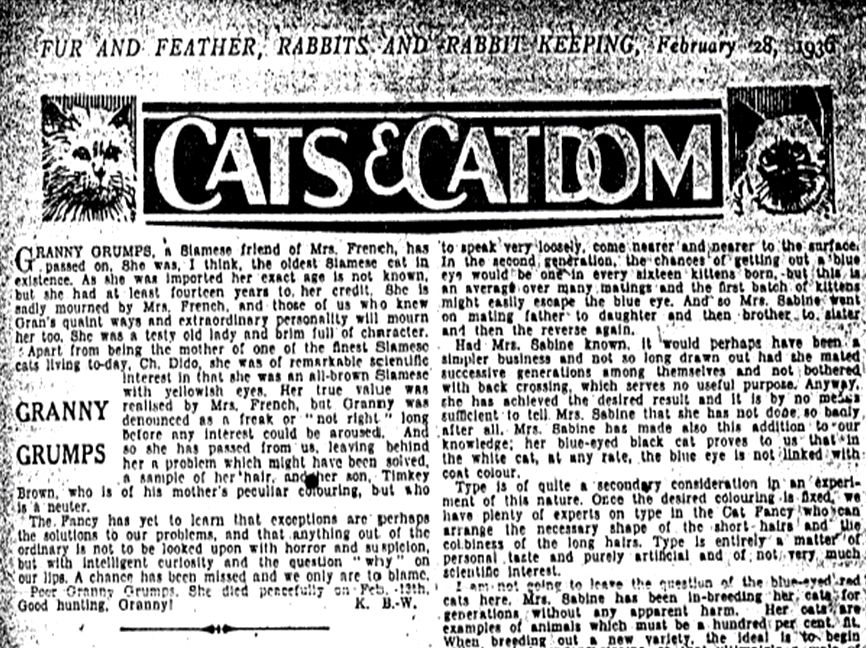
SHORTHAIRED CATS OF THE 19TH CENTURY - SWISS MOUNTAIN CAT (AND CHOCOLATE SIAMESE)
Swiss Mountain Cat ("The Book of the Cat", 1903, Frances Simpson)
Reference was made in Simpson's book to the "Swiss Mountain Cat" - not in the section of shorthairs, but in the section on any other colour Persians:
The best and most definitely coloured AOC I ever saw was Mrs Davies' "Sin Li", a deep self-coloured chocolate-brown cat. He was supposed to be one of three Swiss mountain cats imported to this country, and he was a most handsome and interesting animal. Unfortunately, he died young, leaving no progeny." These brown cats were probably from South East Asia as a branch of the Royal Cats of Siam. An anonymous writer described Royal Siamese as "dun with a darker brown at the head, tail and on the legs, although his feet may sometimes be white, and this is regarded as somewhat of a fault by those breeders perfecting his kind. [...] A lesser relative to him is the Temple Cat, who is dark brown in body, with limbs yet a little darker, and whose eyes are the proper orange. When bred to the Royal Cat, the progeny are neither brown, nor dun, but a dull and undistinguished colour, and with poor contrast between points and body.
From Harmsworth london Magazine of 1900, we have: "Mrs. Sutherland, who lives among the Alps, has bred some beautiful chocolate Siamese cats, the best I have seen being Ma (page 556), who is also in Lady Marcus Beresford’s cattery." and The Encyclopaedia Britannica (11th Edition, published 1910-1911, p 489) says "There is however a wholly chocolate-coloured strain in which the eyes are yellow. (it does not, as many sites suggest, mention Granny Grumps and Master Timkey).
Master Timkey Brown and his dam, Granny Grumps, were cats shown in London. The date often cited is 1894, but this cannot be correct because Granny Grumps died in 1936 and was most likely in her teens. They were owned by Mrs French and described as "Siamese with coats of burnished chestnut with greeny-blue eyes." These self-brown Siamese, known as Swiss Mountain Cat, lost favour and the breed was abandoned after the 1920s following a statement from the Siamese Cat Club of Britain that "The club much regrets it is unable to encourage the breeding of any but blue-eyed Siamese."
Simpson's book also described yellow-eyed brown Siamese cats, probably forerunners of the modern Burmese. With so many years elapsed, it is impossible to say with certainty whether the chocolate-brown cats were equivalent to modern Havanas, Burmese or Tonkinese (the "greeny-blue eyes") - the modern breeds are western refinements of the multiple varieties being imported from Thailand in the late 1800s and early 1900s.
In addition to Master Timkey Brown, Granny Grumps (sometimes just known as "Grumps"), who was of unknown parentage, had many kittens, most of whom were Siamese-patterned. These included Champion Dido. Oddly enough, Granny Grumps' pedigree line is thought to be represented today by Abyssinian cats due to her great-granddaughter, Melodious Venture, being used as an outcross for the Abyssinian breed. Granny Grumps' obituary described Master Timkey as a neuter, but other sources (which I've not traced yet) contradict this.
On 28 February 1936 in Fur and Feather the following obituary was written for Granny Grumps:
Granny Grumps, a Siamese friend of Mrs French, has passed on. She was, I think, the oldest Siamese cat in existence. As she was imported her exact age is not known, but she had aat least fourteen years to her credit. She is sadly mourned by Mrs French, and those of us, who knew Gran’s quaint ways and extraordinary personality will mourn her too. She was a testy old lady and brim full of character. Apart from being the mother of one of the finest Siamese cats living today, Ch. Dido, she was of remarkable scientific interest in that she was an all-brown Siamese with yellowish eyes. Her true value was realised by Mrs French, but Granny was denounced as a freak and ‘ not right’, long before any interest could be aroused. And so she has passed from us, leaving behind her a problem which might have been solved, a saample of her hair and her son Timkey Brown who is of his mother’s peculiar colouring, but who is a neuter. (The Fancy has yet to learn that exceptions are perhaps the solutions to our problems, and that anything out of the ordinary is not to be looked upon with horror and suspicion, but with intelligent curiosity and the question ‘why’ on our lips. A chance has been missed and we are only to blame. Poor Granny Grumps. She died peacefully on February 13th. Good hunting Granny. - K.B-W

A “copper coloured” Siamese cat is mentioned in the article “Mrs. Brassey at Home,” [Normanhurst Court, a mansion at Catsfield, Sussex, demolished in 1951] in the Hastings and St Leonards Observer of 22nd May, 1880. “Mrs. Brassey lived three miles from Battle station on the south coast. “My hostess takes her seat in a bath chair drawn by a donkey, and as she progresses the harness bells advertise her approach to the various members of the animal kingdom, who are instantly on the ‘qui vive’ as she comes within hail of their domiciles. There are Himalayan and other fancy Javanese rabbits and peacocks in pens, and a copper coloured Siamese cat in [the] gardener's cottage be visited.” Sadly we have no pictures of this cat. In 1881, she became Lady Brassey when her husband was knighted. In “Ye Olde English Fayre At St. Leonards,” in the Hastings and St Leonards Observer of 12th November, 1881 it says “The principal attraction, however, was some Siamese cats. Two of these had only been in England for about 10 days, and they were born in the Royal Palace of his Majesty the King of Siam, at Bangkok. They were sent over to England as a present to Lady Brassey from his Majesty.” In the Hastings and St Leonards Observer of 26th November, 1881 an article on the Oriental Fair says “Lady Brassey's exhibition, which she presided over, consisted of the famous Siamese cats.” The Brasseys were keen sailors and Lady Brassey died of malaria in 1887 while travelling. She had at least 3 Siamese cats, one copper coloured and the other presumably “Royal” Siamese (seal point). Had it not been for her untimely death, she might have brought back other cats from her travels.

According to Miss Forestier Walker "There are two distinct varieties in the present day. (1) The royal cat of Siam, cream-coloured in body, with sharply-defined seal-brown markings on head, ears, legs, feet and tail; eyes a decided blue. The cats generally become darker after two years old, but where great care has been taken in breeding the true royal cats keep the light colour longer. The larger, lighter coloured cats have china or ultramarine blue eyes, the more slender, darker cats have deeper-coloured eyes. (2) The chocolate cats are deep brown in colour, showing hardly any markings and have blue eyes." and Mrs. Robinson says "The points of the chocolate Siamese are the same as the royal, with the exception of body colour, which is a dark rich brown all over, thus making the markings less noticeable. All Siamese cats darken with age, and when they get dark, there is a tendency to call them chocolates. I know of only one real chocolate - Mr. C. Cooke's 'Zetland Wanzies' - so consider them more likely to be a freak than a distinct variety." Mrs. Parker-Brough says "There are distinct varieties of Siamese known to fanciers - the palace or royal cat, the temple cat (chocolate), and there is likewise the common cat of the country, which is also found within the palace. The points of the chocolate cat are identical for shows with those of the royal except for body colour, but the imported chocolate is often dark chocolate, with blue eyes, stumpy tail with a marked kink, short legs, and heavy thick body. There are not many chocolates exhibited, owing to the preference given to the royal variety and Mrs Carew Cox (a cat show judge) added The chocolate Siamese are of a rich chocolate or dark seal, with still more intense points. These cats usually possess eyes of rich amber." (The Book of the Cat)
Mrs Sutherland and Miss Sutherland were 19th Century breeders of “Chocolate Siamese.” These were described as brown-bodied and blue-eyed indicating Tonkinese mink pattern rather than the modern Burmese or Chocolate Brown Oriental. Some breeders of Royal Siamese (seal points) recommended breeding chocolate Siamese to Royal Siamese, but this risked producing cats with poor contrast between body and points. They did not have the benefit of knowing that Siamese x Tonkinese produces a mix of colourpoint and mink offspring. Some of those chocolate Siamese could have produced Burmese-pointed cats when bred together, though these were probably lumped in with chocolate Siamese and annotated as having golden eyes (I base this assumption on the fact that some studbooks annotated chocolate Siamese with “blue-eyes” which suggests that not all had blue eyes). The inevitable early Chocolate Pointed Siamese were simply seen as substandard Royal Siamese. According to "The Book of the Cat" One great object of the Siamese Club is to encourage the distinct breeding of the royal cat of Siam and also of the chocolate cat of Siam - both beautiful in their own way, but recognized as distinct breeds [...] Another paper advises the mating of royal Siamese with the chocolate variety. It is true that the young kittens are very pretty, but after six months old quickly become dark and blurred. The great beauty of the royal Siamese is the contrast between the sharply defined, deepest brown markings and a body of as light a cream as possible.
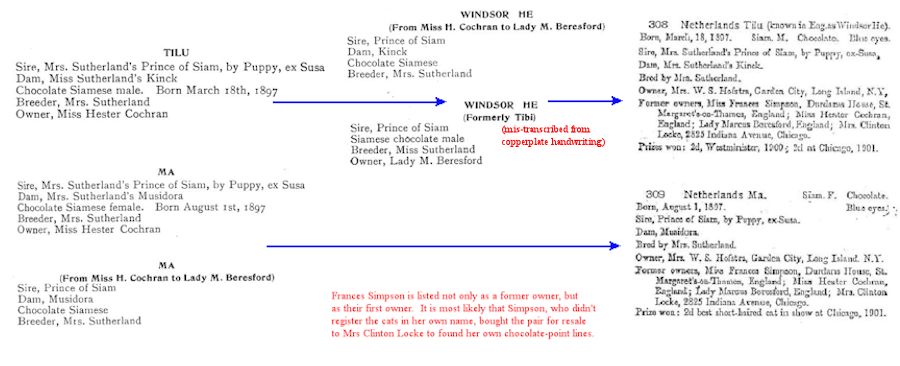
In the American “Cats” magazine in November 1972, Angela Sayer wrote the following about brown Siamese cats. “Self-colored brown cats have appeared from time to time throughout cat history: the earliest record is of Mrs. French’s two, ‘Granny Grumps’, an imported cat, and her son ‘Master Timkey Brown’, just before the turn of the century. They were described by a contemporary writer as being of Siamese type with greenish-blue eye color and coats of burnished chestnut. Cats of this variety were acclaimed on the Continent and even had classes provided for them at some shows but fanciers in England were not sufficiently impressed to start breeding them seriously. At this stage these cats were called Self Chocolate Siamese, and it was not until the 1920’s that several British Fanciers took up the breed once more and, in 1923, a Sister Stockey imported a Self Chocolate called Adastra, believed to be the ancestor of a great many of our present-day Chocolate-point Siamese. A great confusion existed in the early days of the cat fancy between the self brown that is genetically a self-colored Chocolate-point Siamese, and the brown Burmese/Siamese hybrids or 'Tonkinese.' This accounts for the many and very varied accounts of brown cats and their varying descriptions. Chestnut Browns are born brown, but the Burmese and Burmese/Siamese hybrids are born cream or beige, the hybrids later develop slight points. If the two types were indiscriminately mated together, as they doubtless were, by breeders with little or no genetic knowledge, the results would have been most disappointing for them, with predominately Siamese and Black kittens turning up and virtually no self browns at all. These breeders would then have felt that the 'brown' cat was, after all, only a sport, and would then have abandoned their breeding programs and concentrated on easier breeds such as Siamese.”
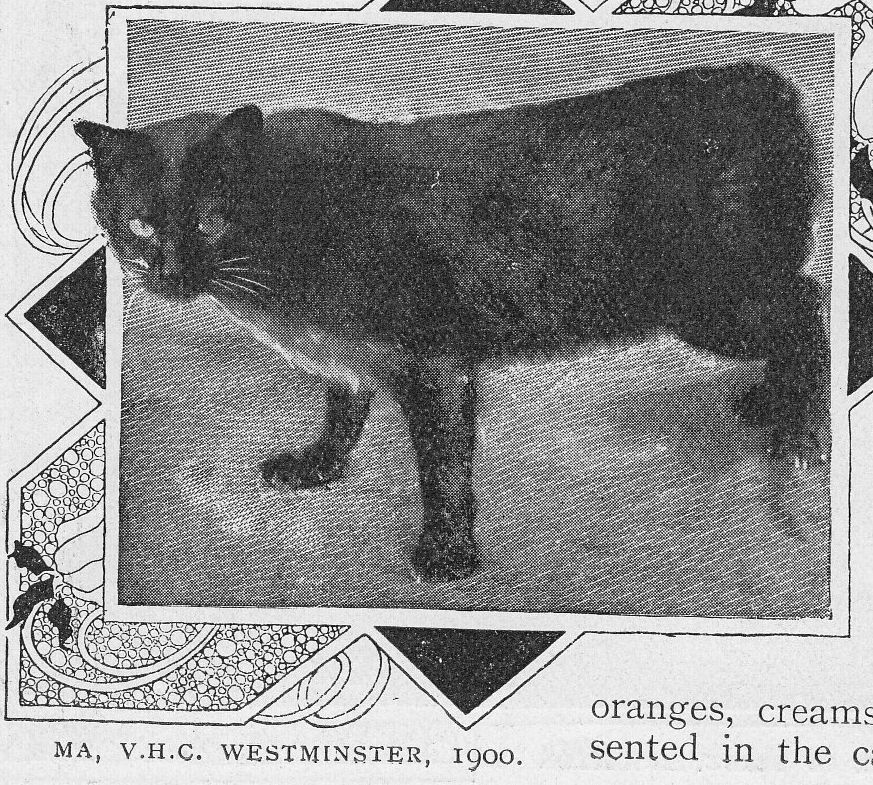
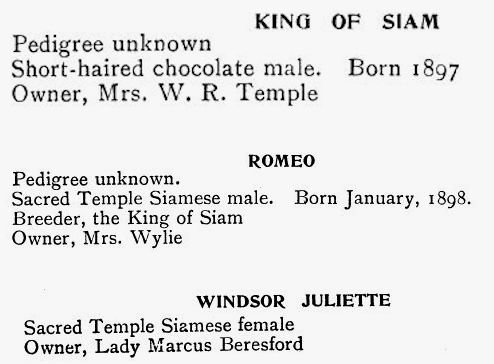
Another brown self-coloured “Siamese” was imported into England by Mary Russell, Duchess of Bedford. This cat, Bogie, was a dark brown self-coloured cat and is mentioned in Louis Wain’s article "Duchess of Bedfords's Pets" after he visited the Bedford’s estate at Woburn Abbey: “Bogie, a whole-colour, very dark-brown cat, is likewise a Siamese, and a vixen into the bargain. She has a philosophy of her own in regard to the treatment of furniture, and will play sad havoc with silk, damask, and even 'down' cushions when she gets the chance. Consequently she is usually banished to an upper storey, or the grass lawn, whereon to work her wicked wiles.” Bogie resembled the early American Burmese cats in terms of colour and conformation.
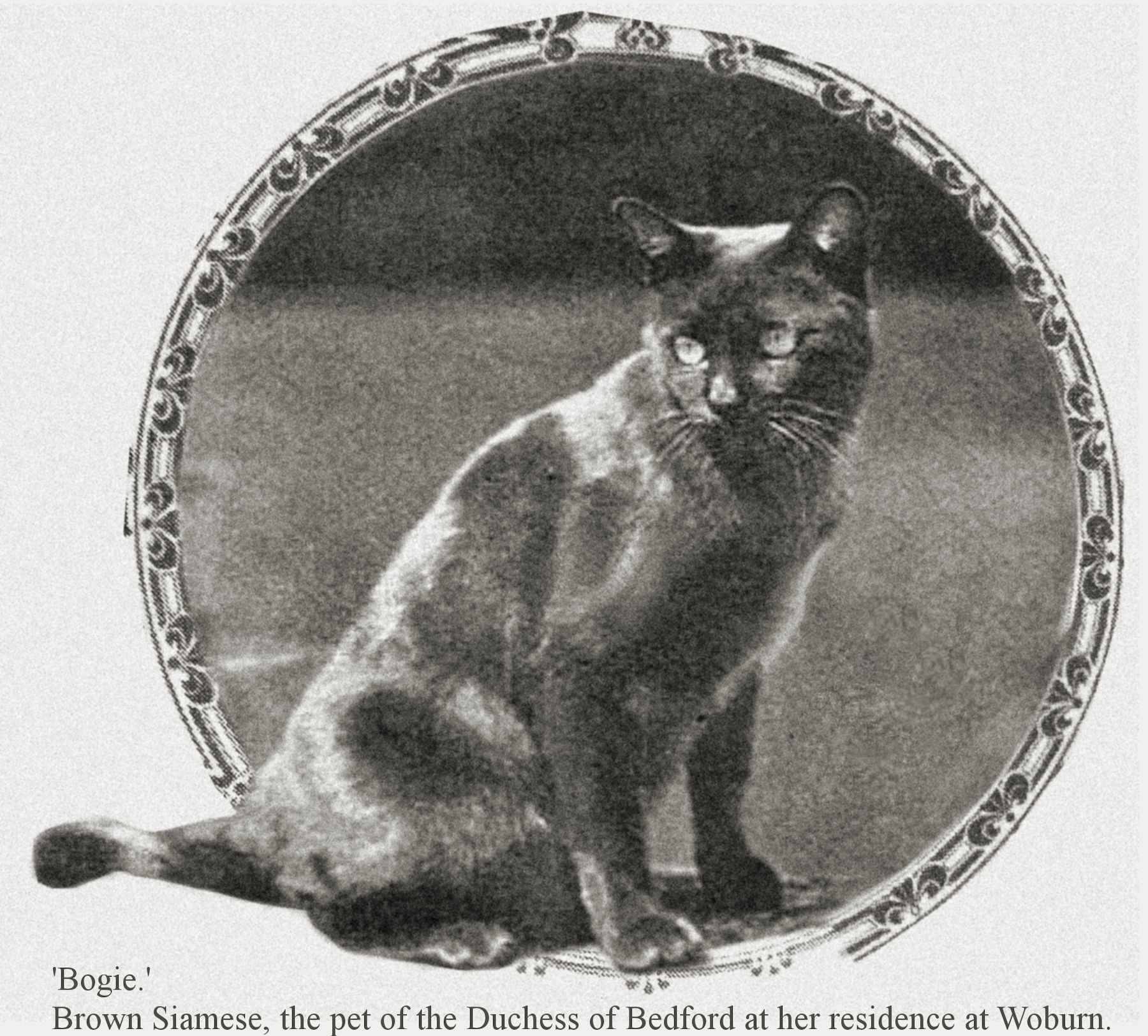
The Sutherlands bred Siamese cats between 1884/5 and 1899. According to The Book of the Cat, “Miss Sutherland, who lives in the south of France, used to breed a lot of good Siamese from her imported Prince of Siam.” Prince of Siam had apparently been imported by Miss Forestier Walker, though no date was given. Since he was siring offspring born in 1897 he must have been at least 1-2 years old by then. According to Mrs Carew Cox, in 1883, sisters Miss Forestier Walker and Mrs Vyvyan, imported Royal Siamese cats Susan, Samuel and Tiam-o-Shian I from Bangkok. These were direct ancestors of many well-known early Siamese cats, including Bangkok, Tiam-o-Shian II and Prince of Siam. Prince of Siam was not imported from Siam, but was directly descended from imported cats. Why is he so important? It seems that the chocolate gene can be traced to him. According to Beresford Cat Club Studbook Vol. II (1901), Prince of Siam was born 1894/95 to (Sire) Puppy x (Dam) Susa i.e. British-bred. However, he is not listed (under that name) in the Siamese Register compiled by Major E. Sydney Woodiwiss in 1924. It’s likely this was not the cat’s original name, but wasthe name Miss Sutherland gave him when she acquired him, or when she moved him to the South of France. Based on birth-date and parentage, the studbooks have two potential candidates. Puppy x Susa produced a litter comprising Princess of Siam (f), Siam of Kepwick (m) and Bangkok of Kepwick (m) in May 1895. They were bred by Mrs Chapman. Siam of Kepwick was owned by Mrs McLaren Morrison; the early cat fancy was a close-knit circle and these ladies were associates of the Sutherlands. It is likely that one of the two males was renamed 'Prince of Siam' by his new owner, a common practice in those days and one which makes line-chasing a challenge. Miss Sutherland had a residence in St. Leonards, but usually lived in the South of France hence The Book of the Cat says “Miss Sutherland, who lives in the south of France, used to breed a lot of good Siamese, from her imported 'Prince of Siam'” which we can now assume refers to his importation into France, not into Britain. Whether Miss Sutherland knew that her cat carried chocolate isn’t known, although she would probably have been aware that some of his ancestors had thrown Brown Siamese “sports.”
In 1894, the cat section of The Ladies Kennel Association's journal described the two types of Siamese cat as “All these cats follow two types, the more common being dun or ashen fawn with black points, the rarer being the ‘seal’ or chocolate with darker face, ears and tail, the legs shading downwards into almost black feet.” In November 1896 the same journal reported that Miss Sidney Cunningham had purchased Puppy II from Mrs K O Chapman, including photos of Puppy II and his littermate Gindura. While Gindura was “beautifully representative of the lighter variety, the other of the chocolate ... Puppy is a very rich chocolate colour, with almost black points." The journal reported that the Siamese were becoming so numerous it was proposed to provide classes “for the chocolates as well as the duns”. Presumably Puppy II was the son of Puppy, probably from Puppy x Susa; it’s hard to be certain because in those days it was quite common for a purchaser to change a cat’s name entirely.

Mrs Herbert Ransome (founder of the specialist “Our Cats” magazine in 1899) suggested that Miss J Derby Hyde, who owned Chocolate Siamese female “Missis,” (Prince of Siam x Kinck) brought together Siamese breeders to discuss the confusion that surrounding the judging and breeding of the two varieties of Siamese. On 16th January 1901, the Siamese Cat Club held its inaugural meeting in the offices of Our Cats. The club’s objective was to “encourage the breeding of pure Siamese cats, both Royals and Chocolates”. In 1902, when Harrison Weir wrote the first Siamese breed standard on behalf of the Siamese Cat Club, he wrote “The points of the ‘Chocolate‘ Siamese are the same as above, with the exception of the body colour”.
The Siamese Cat Club’s committee members published the following letter in “Fur and Feather”: “The Committee of the Siamese Cat Club wish to draw attention to the unfortunate diversity of opinion concerning Siamese Cats expressed in articles which appear from time to time in some of the papers which devote a portion of their issue to cat news. One great object of the Siamese Club is to encourage the distinct breeding of the royal cat of Siam and the chocolate cat of Siam – both beautiful in their own way, but recognised as distinct breeds.” It was signed by Mrs A Forestier-Walker, Mrs Jean A Spencer, Mrs Mary Robinson, Mrs L Parker-Brough, Mrs S E Beckhouse and Mrs Constance Carew Cox.
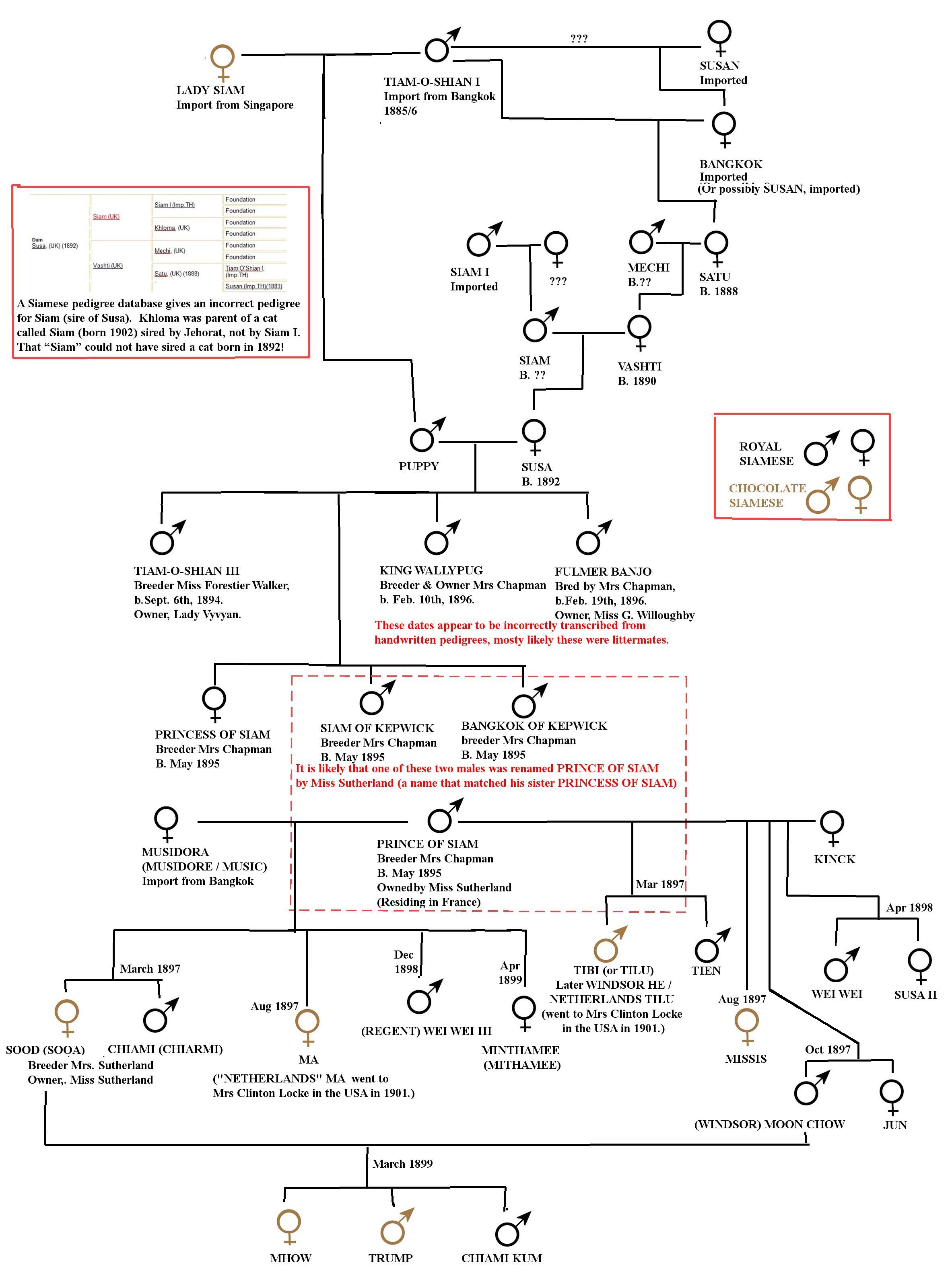
More about the Chocolate Siamese can be found in “Cat Gossip,” of September 28, 1927, in a column called "Siamese and Their Owners" penned by "Muang Thai": From Mrs. Croucher, who lived for some time in the Far East came the following interesting notes: There are no true black Siamese; there are chocolate Siamese, dark brown with blue eyes; I brought one of them, as a kitten, back with me from Siam, but he died last Autumn. Then there is the Siamese cat which we breed here, light fawn with blue eyes and there is a brown Siamese with yellow eyes. [. . .] There are no Temple cats; no doubt the origin of this idea was the fact that when a cat is chased by the natives he often seeks shelter in a Temple; once there he is on sacred ground and may not be touched. Therefore there are usually many cats to be found prowling round the ‘Wats’ (Temples). The late King Rama VI did not breed cats; he was mostly to be seen with toy dogs following him about. But I believe his father, King Chulalongkorn (1868-1910) kept some [cats].
Note by H.C. Brooke, Editor of Cat Gossip: It will be seen that Mrs. Croucher knocks some cherished beliefs very hard on the head. As regards the chocolates, at the last Paris Show we saw more chocolate Siamese that we have seen in all our experience before, and really handsome some of them were. Those of a very decided chocolate, the ‘half-and-halfs,’ were not so attractive.
"Cat Gossip" of 14th December 1927 has more in the same column: Mrs. Basnett writes us as follows:- “I was very interested in the article referring to so-called chocolate Siamese with golden eyes, recently exhibited at Croydon, and I agree with Major Woodiwiss that the darker kittens in the litter were a ‘throw-back,’ as the mother has an extraordinary colouring for a pure Siamese. Several years ago I mated my queen, Yolanda, to Mrs. Robinson’s Bigabois, and in due time six kittens were born, one pure white as usual, and the other five were the colour of a piece of chocolate all over, with no sign of white or a paler colour anywhere. Mrs. Robinson said Bigabois had never before sired any chocolate kittens, and I, not knowing then anything of the chocolate and golden-eyed Siamese, had four of these, as I considered, disappointing kittens put to sleep, rearing only one chocolate and the white one; the latter developed the dark points, and grew in the usual way with blue eyes; the other grew up and never changed his colour, always being a rich chocolate with golden eyes, a perfect wedge-shaped head and slim body, and a tiny hook at the end of his tail. A lady visiting me one day fell in love with him, and I gave him to her, but the village blacksmith had no love for the strange animal, and, watching his opportunity, shot him! Yolanda was six years old when she gave me this strange litter; always before and after this her kittens were normal. She came from Siam before the war, and when nine years old I exhibited her at the N.C.C. for the first time, when she won championship, three firsts, two seconds, etc., proving that as a show specimen she was all a pure Siamese should be, and the dark kittens at Croydon were nothing like Yolanda’s real chocolate family.”
The Editor, H.C. Brooke, noted "What a calamity that these kittens were not reared! At the Paris Show we saw most lovely chocolates, far above what we see here; but none, as far as we noticed — we were feeling very ill at the time — with golden eyes. We especially observed a magnificent dark cat — real chocolate colour, grand type." A little further on in the same issue is the note “The real Temple cat is a very dark chocolate, or jet black; the latter is very rare, and much desired; the black cat has deep golden eyes. Can anyone tell me why an ordinary pair of Siamese cats can produce a jet black cat with golden eyes; two such specimens have been born in England; one of them I have seen, and there was no ‘mesalliance’ in the case of either. They say a black cat can be got by breeding straight down for five generations; alas, with the present death rate it would be an almost impossible feat.”
Although this is not described as a Siamese or Oriental cat, "Cat Gossip" of 29 February 1928 briefly mentions a self brown shorthair: "Considering its rarity, we can only regard it as a sad example of the apathy displayed by fanciers to S.H., that the very interesting self-brown exhibited by Miss Harpur at Kentish Town attracted so little attention. We were, unfortunately, unable to see it, though we had heard about it long before, but from all accounts it must be a very interesting and curious cat, and we wish it were our property!"
Cat Gossip 9 January 1929 has this very brief mention: "We deeply regretted to learn that Mrs. French's “Cigar-coloured" Siamese kits are dead." Unfortunately the issue from 2 January is missing, but the "cigar-coloured" does bring to mind the Havana (UK) and Havana Brown (US) (known as Suffolk in the UK) breeds.
With the benefit of modern genetics, we know that it is impossible for a "Siamese" colourpointed cat to produce a solid colour cat. The most likely explanation is that some of those early Siamese cats were actually “Tonkinese” and therefore produced cats that appeared to be solid seal-brown or chocolate. It's an interesting twist of fate that Tonkinese-type cats were apparently imported into both Britain (as Siamese) and the USA (as Burmese) and became different breeds in each country. If nothing else, all of these “Brown Siamese” with either copper or blue-green eyes, show us that walnut-brown Wong Mau, who arrived in the United States in 1930, was not the first Burmese or Tonkinese in the west (a cat called the Burmese was depicted in Frances Simpson’s “Book of the Cat,” but it is analogous to the Oriental Ticked Tabby).